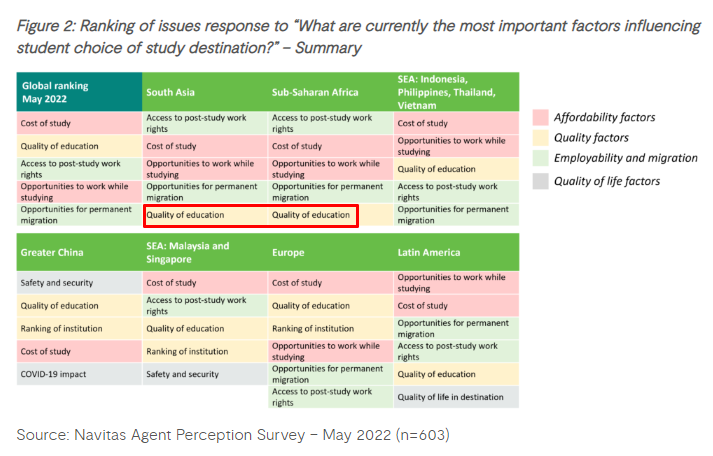The former Morrison Government implemented a range of reforms aimed at driving a “rapid return of international students”. In particular:
- The number of hours that international students were allowed to work while studying were uncapped (previously students were only permitted to work 20 hours a week);
- Vocational Education and Training (VET) sector graduates would now receive a two-year Temporary Graduate visa.
At the time, I noted that these visa changes would “inevitably lead to thousands of poor students from developing nations (e.g. the Indian sub-continent) undertaking cheap mickey mouse courses in order to work and gain permanent residency”.
Alas, that is precisely what has happened, with the Australia Asia Forum reporting a 500% increase in student visa applications from India.
A recent survey from education company Navitas showed that work rights and residency are the top concerns of South Asian students, whereas quality of education is ranked last:

Students from South Asia and Sub-Saharan Africa care about work rights, not quality of education.
Indian newspaper Mathrubhumi also explained how work rights and immigration are the primary objective of Indian students, not gaining an education:
Most of the young people who go abroad want to spend their future life in those countries. For most young people, studying abroad is just a way to immigrate to those countries…
Young people going abroad from here do not make decisions based on the world ranking of the institution they are going to study.
More and more young people go to countries where they can get a student visa as soon as possible and get citizenship or permanent residence visa after studies. This becomes clear if a study is done based on the courses chosen by the youth, institutions as well as countries. Only a very small number of young people go for higher studies after studying the courses and institutes very seriously.
The Albanese Government directly incentivised Indian students to come to Australia by using the Jobs & Skills Summit to uncap working hours for another year and extend post-study work rights for two years for students studying in areas of skills shortages.
Labor has since announced that from mid-year the number of hours an international student can work will again be capped. However, this cap will be increased to 24 hours a week from 20 hours previously in a bid to make Australia more attractive to students seeking to work:
The Government has also announced an increase to the working hour cap for international students, from 40 to 48 hours per fortnight, when the cap is reinstated on 1 July 2023.
With this background in mind, it is alarming to read that student volumes from Indian are set to soar even further on the back of a new mutual recognition agreement signed between the two nations:
One million Indians turn 18 every month…
Efforts to enhance the lucrative international student market received a boost last week, with new arrangements trumped by Mr Albanese on his visit for thousands of Indians studying in Australia to have their qualifications recognised when they return home…
[Education Minister Jason Clare] said Australian universities are well-placed to help India reach its goal of having half of all young adults in tertiary education by 2035.
“India is huge – 1.4 billion people. There are plenty of students. So, our mindset is not about being competitive with other universities, it is about growing the market share,” [Victoria University’s chief international officer Monty Singh told The AFR.
“Other universities have probably got the jump on us, but we’re determined to catch up quickly,” [Melbourne university deputy-vice chancellor international Michael Wesley said].
“Competition for Indian students is definitely rising. When it comes to international education, the earlier you start recruiting and the more graduates you have, the more of a recruiting tool graduates become”.
Late last year, Labor backbencher Julian Hill warned that Australia’s international education system had become a “ponzi scheme” for enticing non-genuine students with unfettered work rights and permanent residency, which were being ruthlessly exploited by some education agents:
“Uncapped work rights is being misused by agents in many parts of the world who are flogging our precious student visa as some kind of cheap, low rent work visa. No one should permit that to continue,” Mr Hill said…
“We know that the incentive of a permanent visa to Australia is like a golden ticket from Willy Wonka’s chocolate bar,” Mr Hill said.
“It’s too powerful an incentive that would drive and pervert behaviour by providers, and some students.”
Now the Albanese Government has sent this ponzi scheme into overdrive, which will crater wages and tighten the rental market even further.
Instead of operating a ponzi scheme by opening the floodgates to India, why not instead aim for a smaller intake of higher quality international students via:
- Raising entry standards (particularly English-language proficiency);
- Raising financial requirements needed to enter Australia; and
- Removing the explicit link between studying, work rights and permanent residency.
These reforms would raise student quality, would lift export revenues per student, would improve wages and conditions in the labour market, and would reduce enrolment numbers to sensible and sustainable levels, in turn improving quality and the experience for local students and reducing population pressures.
Sadly, Labor knows that if work rights and permanent residency were scaled back, the numbers of students arriving would plunge, alongside Labor’s Big Australia agenda.
So instead, Labor has ushered a housing and inequality disaster via its idiotic immigration policy that explicitly encourages quantity over quality.

